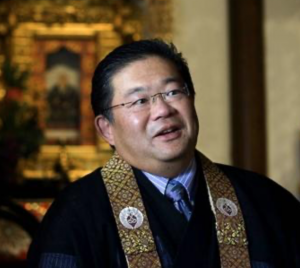
Jodo Shinshu Buddhism faces big challenges in this country in its propagation and acceptance. We recently asked Rev. Jerry Hirano, director of the Buddhist Churches of America’s Center for Buddhist Education, how to meet these challenges. Rev. Hirano also is minister of the Salt Lake Buddhist temple and oversees Utah temples Ogden and Honeyville, as well as the Idaho Oregon temple. Below are excerpts from our conversation.
Do you think Jodo Shinshu needs to be adapted and interpreted differently to be more widely accepted in this country?
JH: I don’t like idea of “American Shinshu.” There’s no change in that people are born and they die. Jodo Shinshu is about the truth of being a human being… I’m not a believer in flattening out our Jodo Shinshu doctrine to make it more “American.”
I believe Jodo Shinshu is about understanding this human life we have received. It’s not Japanese, American, or any specific gender. Humans come in a variety of forms. Therefore, Jodo Shinshu must be able to relate to all human beings.
No doubt, Jodo Shinshu Buddhism can be helpful in people’s lives. How are you getting out this message?
JH: Of course, we try to make all our lectures understandable. Trying to speak to people at all levels is difficult for our local temple ministers… We have the resources to ask people from all over the world to explain Jodo Shinshu concepts in a way they may understand.
Social issues are important. However, how we approach topics such as social justice may be different than Christian social justice. LGBTQ issues also are important, but to understand these, we must first understand how Jodo Shinshu affects our common humanity. Then we can show how inclusion is a natural part of our religious tradition.
There is often a tendency to dumb down our doctrine to fit into the compartment of what we call America. I believe in explaining our doctrinal beliefs in a clear concise manner. A dilution or flattening will not be necessary.
I would say our seminars are not traditional Dharma talks. I try to get speakers I personally know who are spiritual in their outlook of their particular area of expertise. For example, Johnny Mori (musician) is not a minister, yet I know he is very Jodo Shinshu. So I asked him to speak about Taiko.
The same may be true of Dr. Winn Kiyama, music professor at Portland State University. He is not a minister, but he is very Shinshu in his outlook of what Obon (summer memorial) means.
Our upcoming events include a seminar on Taiko and “Embraced and Never Abandoned: Jodo Shinshu and LGBTQ+.”
What has the Center for Buddhist Education been doing during the pandemic this past year?
JH: As you know, the Jodo Shinshu Center and all the BCA temples have been closed due to the Covid Pandemic. From May 2020, we switched to all online programs.
Rev. Dr. David Matsumoto and Rev. Kiyonobu Kuwahara spoke on death and the Pure Land. Reverends Harry Bridge, Jon Turner and Landon Yamaoka spoke about Jodo Shinshu and Science Fiction, and Higashi Honganji’s Rev. Ken Yamada spoke on the differences between Nishi Honganji and Higashi Honganji. We also held online an Obon dance and a Youth retreat.
What is the Center of Buddhist Education’s mission?
JH: Originally, the Center for Buddhist Education was set up by Rev. Kodo Umezu under Bishop Koshin Ogui. The intent was to have programs that would offset graduate level courses offered at the Institute of Buddhist Studies (IBS). There would be lectures and programs the average BCA member could benefit from. The programs such as the BCA Minister’s Assistant Program were originally a part of CBE. We have established three major areas: Academic/Doctrinal, Popular Culture (BCA and General), and Practical Application of Jodo Shinshu.
What are your plans for CBE going forward?
JH: With the experience of moving all of our programs online, we will continue to record and present them on the Internet. However, we are planning also to include live in-person events beginning this January. Hopefully when we begin our live programs, we can go beyond “Zoom” and make them even better.

